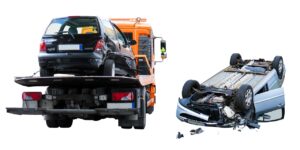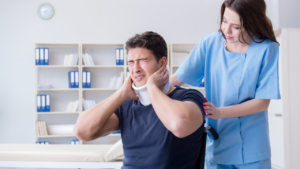What happens if someone reports your plates after a hit-and-run? what do you need to do?
Imagine yourself rushing to get back from work while you are driving home. You’re involved in a hit-and-run accident all of a sudden, and you’re terrified. You don’t want to wait around for the other driver to report the number on your license plate. But if they do, what will happen?
Have you ever been in a hit-and-run and been concerned that your license plate would be reported? Although it’s a frightening idea, it’s crucial to understand what can occur if someone does report them.
And, what if the police come to your home and you have to deal with the legal repercussions?
If you need a quick answer, here we go.
If someone reports your license plate after a hit-and-run, authorities will investigate, locate your vehicle and identify the driver. If you were involved, you may face criminal charges for leaving the scene of an accident, pay fines, jail time, or have a suspended license.
To expand on my answer above, I’ll go over the possible results of a reported license plate in this article and offer advice on how to address it. As a result, you’ll be ready in case it ever does happen to you, ready let’s go!
Page Contents
What do understand by a hit-and-run car accident?
If you have been driving for a while, you have probably experienced, witnessed, or heard about hit-and-run auto accidents. To some of us, there is even a likelihood we have committed a couple of them.

But what is a hit-and-run? Well, this is simple. A hit and run simply refers to a car or an auto accident in which one driver flees the scene without sharing his contact information or offering the required help to the injured.
From my simple study research, the USA experiences more than 7 million car accidents yearly, and at least more than 700,000 are hit and runs.
How to report hit-and-runs?
You will be surprised to hear that many hit-and-runs go unsolved. In fact, through simple research, I was able to discover that at least 5-10% of hit-and-runs are investigated and solved by police.
The reason why many cases of hit-and-runs go unsolved is the overwhelming lack of sufficient evidence and proper leads.
Every driver is required to stop by and share contact information, insurance coverage policies, car registration, license plate numbers, and any other personal identification information.
This is the very information that is contained in the car accident police report, and this same information is used to track and hold the perpetrators liable for the car accident they caused.

But, what happens if the other driver flees away in the blink of an eye giving you no chance of even noticing the car model and make? What will you report to the police to help investigations and increase your likelihood of getting compensated for the damages you incurred?
Well, I need to tell you that the most implicating pieces of evidence you will need to submit to police are the car license plate numbers, car model and make, and being able to physically identify the at-fault driver.
Having that said, how will you proceed if you were lucky and noted the other driver’s license plate in the hit-and-run accident? Here we go.
Obtaining a License Plate Number from a Hit and Run: Next Steps
I can not stress the importance of being able to produce the license plate number before the police as a piece of evidence in the hit-and-run.
You can get to know about the license plate number if you had installed like these Dash cams on your car, or using any other car camera of this type. You can also search for the hit-and-run footage from any security camera within the vicinity of the hit-and-run.
Learn more: Car accident Police report vehicle 1 and vehicle 2- on a police report who is at fault unit 1 or unit 2
You can also ask the eyewitnesses if any saw and noted down the license plate of the perpetrator driver. Some people who are smart today install automatic license plate readers and with such, you are 100% sure to know the license plates of the hit-and-run offender.
Filing a Police Report for a Hit and Run Incident
Following a car accident, be it a hit and run or not, you or the other driver should endeavor to invite the local traffic officers to the accident scene.
The officers that respond to the accident will compile a car accident report by filling in the earlier mentioned information from drivers, witness statements, pictures of the injuries, car damage photos, any traffic violations, and opinions on why the accident occurred.
Learn more: Chances of getting away with hit and run car accident.
If you were only able to capture the license plates, you will also be able to tell the car model, make, and car color, and this information will also be included in the police crash report for the hit and run.
You will need the help of the hit-and-run crash report later if you need to file a hit-and-run lawsuit or if you choose to file a claim compensation settlement from the insurance company.
Informing Your Insurance Company of a Hit and Run
In addition to inviting the police officers to the hit-and-run accident scene, you will also need to call and let your insurance company know about the car accident.
Different auto insurance companies have varying deadlines by which you should report the accident. You probably do not have more than 24 hours to 30 days to inform your insurance company.
Because the likelihood of finding the hit-and-run offender is so low, you will most likely get compensated by your own personal insurance coverage. Only collision coverage and underinsured/uninsured motorist policies help cover hit-and-run losses.
Understanding the Implications of Hit and Runs and License Plate Numbers
I already mentioned that being able to identify car license plates is paramount as far as pursuing a hit-and-run case is concerned.
A car’s license plate number is the easiest piece of evidence you can get as a hit-and-run victim. The implication of hit and run and the license plate numbers is that the driver that is at fault will actually be hunted down and be held accountable.

Hit and run is a serious offense punishable by law. Depending on the gravity of the hit and run you committed, authorities could press on you a misdemeanor or charges of felony.
You could also pay hefty sums of fines and face jail time of a couple of months to 15 years jail time depending on where you come from.
What Occurs When a License Plate is Reported?
The police or any other authorities will track down the hit-and-run offender using the reported license plate numbers.
A vehicle’s registered owner can be located using the license plate number. You can find out details like these by running a license plate number through a law enforcement database or a third-party service:
Information that the hit-and-run investigating police officers obtain by running your license plate numbers include:
- The make, model, and year of your vehicle.
- The registered owner’s name and address.
- The vehicle’s registered location.
- Whether the vehicle has been reported as stolen, and
- If the vehicle has been involved in any accidents or has any outstanding fines or citations
The Importance of Reporting a Suspicious License Plate
Reporting a suspicious license plate number help is identifying the culprits and hold them liable for the personal injuries, and property damages they caused to the other party.
The fact that you will be charged with hit-and-run, a criminal violation, if you are involved in a hit-and-run and fled the scene raises the possibility of serious consequences for you if you are captured.
In short, it is possible to track down hit-and-run drivers and save accidents in the future by reporting a suspect license plate. It’s also essential to give the authorities any information you have, such as a license plate number, in order to hold the guilty party accountable.
The Potential Outcomes of a Reported License Plate
Outcomes of a reported license plate are numerous as far as tracking down hit-and-run offenders is concerned. Below are examples.
1. Police investigation: When a police inquiry into an event is prompted by a reported license plate number, the driver may be identified and criminal charges may be brought.
2. Vehicle impoundment: The car might be confiscated if the reported license plate is linked to a stolen vehicle or if the driver is discovered to be driving without a license.

3. Civil lawsuit: The victim may launch a civil lawsuit against the driver in order to obtain damages if the reported license plate is linked to an accident that caused injuries or property damage.
4. Fines and penalties: If it is determined that the driver was at fault, they may be subject to fines and penalties, such as those for hit-and-run, abandoning the scene of an accident, and failing to report an accident.
5. Insurance implications: If the driver is determined to be at fault, their insurance company can be obliged to cover damages. The reported license plate may have an impact on the driver’s insurance rates.
Handling the Situation if Your License Plate is Reported
Of course, there is a higher chance someone will report you by telling your car’s license plate if you committed a hit-and-run crash.
In my own view, I would advise you to follow these 4 steps to handle the situation if your license plate is reported.
1. First of all, don’t worry! If someone reports your license plate, it doesn’t necessarily indicate you did something wrong. It can be a straightforward error or misunderstanding.
2. Look out for the cause of the report on your license plate. For more information, get in touch with the organization that received the report, such as the police force or the DMV. They ought to be able to explain the problem to you and the procedures you must take to fix it.
3. Take action to solve the issue. You’ll need to get any errors on your registration or license plate fixed. You may be required to pay a fine or appear at a hearing if you are charged with a traffic infraction.
4. Keep copies of all communications and paperwork pertaining to the problem. In addition to keeping you organized, this will be helpful if you need to contest the report or pursue legal action. Additionally, always be courteous and helpful to the authorities.
5. Finally if you committed the hit and run, it’s high time you acted smart. You will need to hire a defense car accident attorney to help you through. The attorney will help you by defending you in courts of law or negotiating for a fair penalty.
Preventing License Plate Reporting
1. As everyone would tell you, the best way to prevent someone from reporting your license plate as a suspect in a hit-and-run accident is by trying not to commit one.
2. You can also decide to stay at the accident scene because leaving the scene is illegal and punishable by law. What I need to remind you is that you will still be charged with a hit and run even if you are not at fault for the accident.
3. Exchange information. Leaving the scene without sharing your contact information is illegal. Sharing the wrong information is as bad as not sharing.

4. Call the police. Calling the police helps in getting the car accident report done and this helps in solving liability issues. You may not be to blame for the accident but still be charged for a hit and run if you left and the other driver changes statements or tampers with the evidence.
5. Report the accident to your insurance company. This means that your company could help to report on your behalf, and your rates will not rise due to false accusations.
6. Keep your vehicle in good condition. Maintain your car on a regular basis, making sure all the windows, mirrors, and lights are in good working order so that you can see and be seen on the road. By doing this, the likelihood of being in a hit-and-run accident will decrease.
Conclusion.
Maintain your car on a regular basis, making sure all the windows, mirrors, and lights are in good working order so that you can see and be seen on the road. By doing this, the likelihood of being in a hit-and-run accident will decrease.
The police will look into the complaint and make an effort to find your car and identify the driver. Interviewing witnesses and looking over video evidence may be necessary for this situation.
You can be charged with a crime for fleeing the scene of an accident if the authorities find that your car was truly engaged in the hit-and-run collision. You may be facing fines, jail time, or possibly a suspended license, depending on the seriousness of the accident and any injuries sustained.
Even if you weren’t the one driving the car, you could still be held accountable as the owner of the car. It’s crucial to cooperate fully with law enforcement and to hire a lawyer if necessary.
In rare circumstances, you might be able to escape criminal charges if you can demonstrate that your car was stolen or that someone else was using it without your permission. The best course of action, however, is to remain at the scene of the collision, dial 911, and contact your insurance provider right once.
